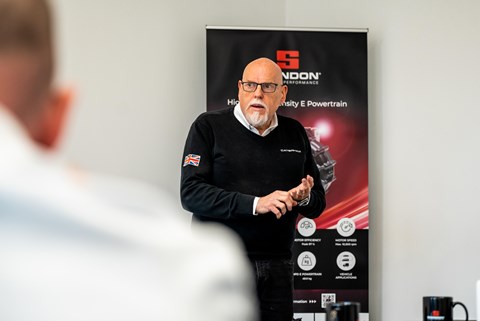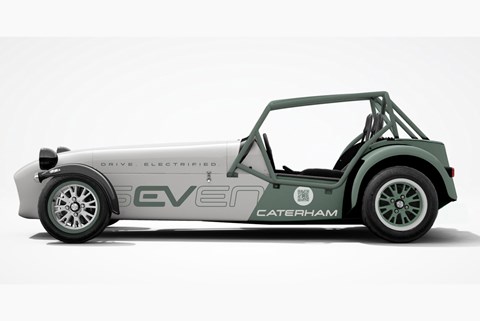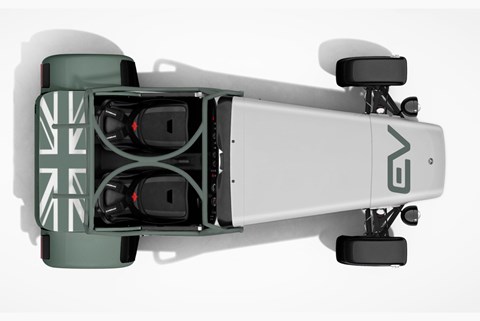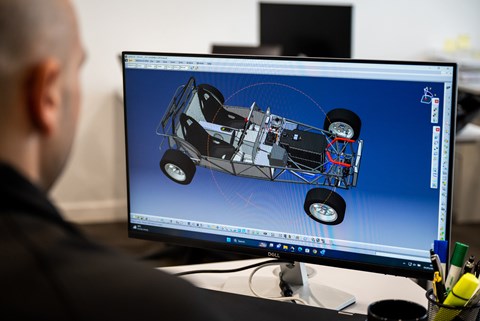► Caterham Cars investigates electric cars
► EV Seven project is a ‘toe in the water’
► Developed with Swindon Powertrain
Caterham Cars is looking towards an electric future, revealing this: the EV Seven. But, before you jump to conclusions, the brand is keen to stress that it’s merely investigating the deployment of an electric powertrain in its future cars.
The EV Seven you see here is a concept, designed to test how feasible a battery-electric version of the Seven could really be. It’s been developed in partnership with Swindon Powertrain – an engineering outfit that’s had a history of developing powertrains for racing cars, including for the British Touring Car Championship.
Here, Caterham and Swindon Powertrain’s investigations into going electric have produced some very interesting results, making something with the potential to become one of the fastest electric cars around.
An electric Caterham Seven? Perish the thought…
And no one is more aware of that viewpoint than Caterham Cars’ own CEO, Bob Laishley (pictured below). ‘Rather than having people knocking on the door asking for an EV Seven, we’ve got a queue of people knocking on the door saying: “please don’t stop making ICE cars”. But I think, ultimately, we’ll either be forced into it by legislation, or forced into it by the fact that we won’t be able to buy engines anymore,’ he tells CAR.

‘There is the potential that we won’t be able to sell ICE cars in certain markets because they’ll be banned, and if that’s a market that we sell a huge volume of cars in, then we need to find an alternative.’
Caterham is staring down the barrel of OEMs killing off any small engines they may produce or modifying them for Euro 7 requirements to the point that they wouldn’t fit inside a Seven’s chassis anymore (or wouldn’t be available for Caterham to licence). As well as future combustion engine bans in certain markets, tightening emissions standards (that even Caterham as a small manufacturer has to stick to) are likely to start biting in the years to come. So, an EV Seven is one of those potential future lifesavers.
And, as you’d expect, Caterham is doing this properly. ‘Any future EV model we produce must be true to the DNA of a Caterham: lightweight, fun-to-drive and driver focused,’ says Laishley, adding that it should be ready for both road and track use – just like a Caterham Seven with an engine.
So, are there any performance specs for this EV Seven?
Plenty. As you can see from the pictures, the EV Seven looks almost identical to a regular one, save for any exhaust tailpipes.

The 51kWh (gross, 40kWh usable) battery pack fits in the nose and runs through the centre console of the car, linked to a Swindon Powertrain HPDE e-Axle and single-speed two-stage reduction transmission. Power is rated at 240bhp and 184lb ft, good for a four-second 0-60mph time and a top speed of 130mph.
The benchmark for performance has been the Seven 485 with the SV chassis – a model available for Continental European and Japanese markets.
‘We’re not aiming for 0-60mph in 1.8 seconds or whatever,’ says Laishley, ‘it’s matching with current combustion car which affords us to reduce weight, and means we don’t have to worry about ripping driveshafts apart either.’
Other performance details include a limited-slip differential, adjustable Bilstein dampers from a Seven 420 Cup and Avon ZZR tyres.

As for charging, the EV Seven project is capable of up to 152kW fast charging, with the aim of engineering a potential future electric Seven to be quick-charged during a track day. ‘If you’ve got an hour long track day session, we want you to be able to use it on track for 20 minutes, stop and charge for 15 minutes while you have a cup of tea, then use it for the last 20 minutes of that hour,’ says Laishley.
It’s gonna be heavy, isn’t it…
That’s been Caterham’s biggest focus and its fiercest target, to keep the inevitable weight increase as low as possible. ‘It’s not an exact science, but the standard reference vehicle [i.e. a Seven 485 SV] we’ve used is 626kg, and we’re really confident we can bring [the EV Seven] to 700kg total – approximately only 70kg extra, the rough weight of an additional passenger on board,’ says John Bond, commercial manager at Swindon Powertrain.
‘We’re never going to launch a one tonne Seven – we’d rather not do it,’ adds Laishley.
The EV Seven, then, manages a power-to-weight ratio of around 340bhp per tonne. Punchy figures.
How have they managed it?
By being utterly obsessive over the details. The benchmark car was meticulously scanned with tools designed to create hyper-accurate CAD (computer-aided design) files for the Swindon Powertrain and Caterham Cars teams to play around with, allowing them to design a battery pack that fits neatly without drastically changing the design of the Seven. ‘It’s the more ambitious part of the project,’ says Bond.

And, in order for the battery pack to sustain intense track day drives and quick charges, the battery pack is cooled using a dielectric fluid. ‘That’s something we think is industry-leading,’ adds Bond, with Caterham pointing out that the Motul-supplied fluid ‘has only typically been employed to cool super computers that generate enormous amounts of heat.’
So, when will they make it?
That’s the thing – there’s no specific date for launch. You have to remember that this is an engineering project for now, as Caterham finds its feet with e-power.
‘We do not have plans to put EV Seven into production at this stage – it’s a test bed to see how well an EV powertrain works for our customers’ specific use cases,’ says Laishley, ‘We’re going to bring this to market at the right time, when the future generation of battery technology allows it, and that’s why now is the time for us to trial the concept.’
The engineering development car will make its public debut at the 2023 Goodwood Festival of Speed. And, on top of the Seven, Caterham has confirmed it’s also working to develop another fully-electric sports car concept completely separate from the Seven, led by the brand’s new Chief Designer, Anthony Janarelly who designed the Janarelly Design-1.